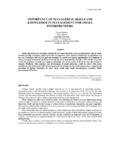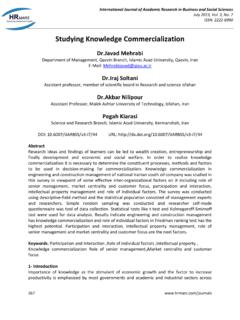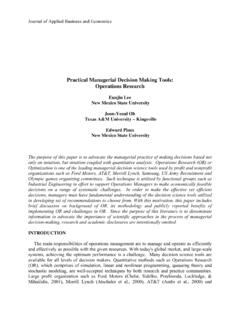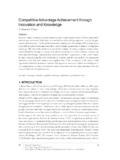Transcription of New Sources of Growth: Knowledge-Based Capital
1 ECD Digital Economy Papers No. XX New Sources of growth : Knowledge-Based Capital Key Analyses and Policy Conclusions SYNTHESIS REPORT 3 NEW Sources OF growth : Knowledge-Based Capital KEY ANALYSES AND POLICY CONCLUSIONS SYNTHESIS REPORT OECD 2013 FOREWORD At the start of 2011 the OECD began work on a two-year project entitled New Sources of growth : Knowledge-Based Capital . For OECD member countries and key non-members it had two aims: to provide evidence of the economic value of Knowledge-Based Capital as a new source of growth ; and to improve understanding of current and emerging policy challenges. It was born out of insights from the OECD s Innovation Strategy, which was released in 2010. The project has drawn on expertise from across the OECD and from streams of work on big data , competition, corporate reporting, the efficiency of resource allocation, global value chains, innovation, knowledge networks and markets, measurement and taxation.
2 This synthesis presents the project s main analyses and policy findings. The Directorate for Science, Technology and Industry, the Economics Department, the Centre for Tax Policy and Administration, the Directorate for Financial and Enterprise Affairs and the Statistics Directorate have contributed to this report. Reflecting the cross-directorate character of the OECD work on Knowledge-Based Capital , the work was discussed and declassified by various OECD Committees including the Committee on Industry, Innovation and Entrepreneurship (CIIE), which took the lead for this work, the Committee for Scientific and Technological Policy, the Committee for Information, Computer and Communications Policy, Working Party 1 of the Economic Policy Committee, the Committee on Fiscal Affairs, the Competition Committee, the Corporate Governance Committee and the Committee on Statistics.
3 The comments and inputs formulated by national delegates to these OECD bodies are greatly acknowledged. This synthesis report was discussed by the OECD Executive Committee and OECD Council and was presented at the Ministerial Meeting of May 2013. Further information about the project is available at 4 NEW Sources OF growth : Knowledge-Based Capital KEY ANALYSES AND POLICY CONCLUSIONS SYNTHESIS REPORT OECD 2013 TABLE OF CONTENTS EXECUTIVE SUMMARY .. 6 THE RISE OF Knowledge-Based 12 Knowledge-Based Capital is essential to investment and growth .. 13 Business investment in KBC is important for growth and productivity .. 17 Knowledge-Based Capital helps to capture value in global value chains .. 23 Many emerging economies are increasing their investments in KBC .. 25 POLICY ANALYSIS AND CONCLUSIONS .. 27 Policy makers should take a broader view of innovation.
4 28 Policy should facilitate efficient resource allocation, which is positively correlated with KBC use .. 30 Efficiency of resource allocation affects employment outcomes from business investment in KBC .. 36 Industries founded on Knowledge-Based Capital create challenges for competition policy .. 38 Appropriate tax treatment of KBC can stimulate investment and growth in cost-effective ways .. 42 For Knowledge-Based Capital , protection of intellectual property rights is a key framework condition .. 47 Better corporate reporting of KBC should be encouraged .. 51 Better policy can help create economic value from data .. 55 Good conditions for the financing of KBC-intensive firms will be needed .. 58 Business investment in KBC amplifies the importance of appropriate human Capital policies .. 63 KBC s profound implications for earnings inequality create a significant policy challenge.
5 65 Governments must invest in better measurement of innovation, investment and growth .. 66 The calibration of macroeconomic policy may need to be revised .. 70 Opportunities exist for international collaboration .. 70 Tables Table 1. Classification of the forms of KBC and their effects on output growth .. 12 Table 2. The protection of Knowledge-Based Capital by intellectual property rights .. 47 Figures Figure 1. Business investment in KBC and tangible Capital , United States, 1972-2011 (% of adjusted GDP) .. 14 Figure 2. Change by type of business investment from 2008 to 2010 (percentage points of value added) .. 14 Figure 3. Business investment in KBC and tangible Capital , 2010 (% of value added) .. 15 Figure 4. Business investment in KBC and GDP per capita, average 2000-10 .. 16 Figure 5. Multi-factor productivity growth and business R&D, 1986-2008 (% of GDP) .. 19 Figure 6.
6 Potential productivity growth in manufacturing when raising managerial quality to the level of global best practice .. 20 Figure 7. ICT investment and KBC are positively correlated .. 21 Figure 8. Knowledge-Based Capital and spillover effects .. 22 Figure 9. Knowledge-Based Capital deepening and the efficiency of resource allocation .. 32 Figure 10. Investment in KBC and selected public policies, 2005 .. 33 Figure 11. Change in employment associated with a 10% change in patent stock, 2002-10 .. 36 Figure 12. R&D tax incentives and direct government funding of business R&D, 2010 (% of GDP) .. 43 Figure 13. World data storage in exabytes (billions of gigabytes) .. 55 Figure 14. Business investment in KBC and the size of the venture Capital industry .. 59 Figure 15. Venture Capital investment as a percentage of GDP, 2009 .. 61 Figure 16. Investment in organisational Capital in the United States, 2002-11.
7 68 5 NEW Sources OF growth : Knowledge-Based Capital KEY ANALYSES AND POLICY CONCLUSIONS SYNTHESIS REPORT OECD 2013 Boxes Box 1. Treating spending on Knowledge-Based Capital as investment .. 14 Box 2. Why is business investing more in Knowledge-Based Capital ? .. 17 Box 3. Estimating business investment in Knowledge-Based Capital in China, Brazil and India .. 26 Box 4. Business process innovation: An example of knowledge spillovers in the airline industry .. 29 Box 5. Design: a form of KBC that drives innovation and growth .. 29 Box 6. The scope for misallocation of KBC is significant .. 32 Box 7. Protecting trade secrets but limiting labour mobility: The role of employee non-compete agreements .. 35 Box 8. The role of young firms in employment growth .. 37 Box 9. R&D tax credits: Assessing their efficacy .. 47 Box 10. Intellectual property rights: Current policy concerns.
8 49 Box 11. Transmitting data: A regulatory barrier to the Internet of things .. 58 Box 12. KBC as financial security: recent developments and policy opportunities .. 61 Box 13. Balancing the supply and demand for skills: the OECD Skills Strategy .. 64 6 NEW Sources OF growth : Knowledge-Based Capital KEY ANALYSES AND POLICY CONCLUSIONS SYNTHESIS REPORT OECD 2013 EXECUTIVE SUMMARY At the start of 2011 the OECD began work on a two-year project entitled New Sources of growth : Knowledge-Based Capital . The motivation for the project was two-fold. The first was to examine in depth a finding highlighted by the OECD s 2010 Innovation Strategy, namely that many firms that innovate do not invest in R&D. Instead, innovation in such firms is based on investments in a wider range of intangible assets Knowledge-Based Capital (KBC). Secondly, the NSG-KBC project aims to help govern-ments and policy analysts better understand the determinants of growth .
9 Today, the importance of growth can barely be overstated. The drawn-out nature of the global crisis, sluggish macro-economic conditions in many OECD economies, weak labour markets and burgeoning public debt have all added urgency to the search for new Sources of growth . Furthermore, rapidly ageing populations, combined with natural resource constraints, mean that the future of growth in advanced economies will increasingly depend on productivity-raising innovation. Drawing on inputs from across the OECD Secretariat, the work summarised in this synthesis report aims to provide evidence of the economic value of Knowledge-Based Capital as a new source of growth and to improve understanding of current and emerging policy challenges. KBC results from business investment in non-physical assets such as research and development (R&D), data, software, patents, new organisational processes, firm-specific skills and designs.
10 In many OECD countries, business investment in KBC has increased faster than investment in physical Capital (machinery, equipment, buildings). In some countries, business investment in KBC significantly exceeds investment in physical Capital . KBC and growth Inherent features of KBC are growth -promoting, and various forms of evidence link business investment in KBC to growth and productivity change. Unlike physical Capital , KBC can foster growth because the initial cost incurred in developing certain types of knowledge is not re-incurred when that knowledge is used again. This can lead to increasing returns to scale in production. Investments in many forms of KBC such as R&D, design and new business processes also create knowledge that spills over into other parts of the economy, again spurring growth .

















